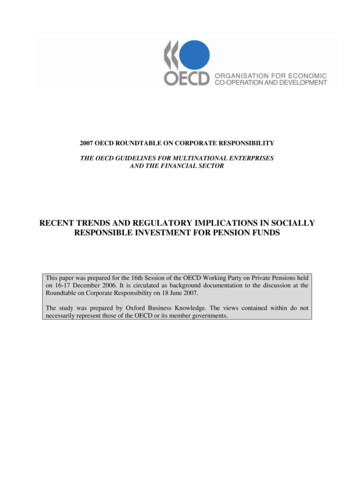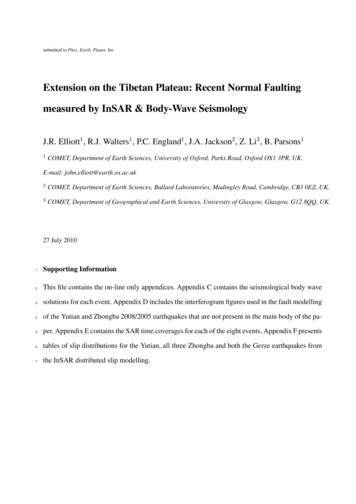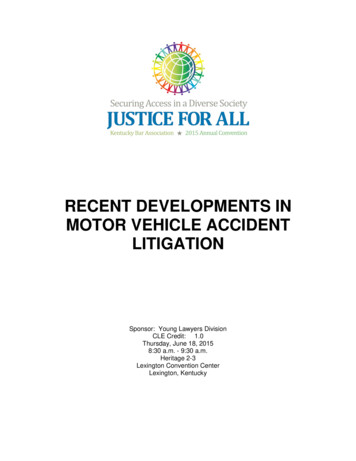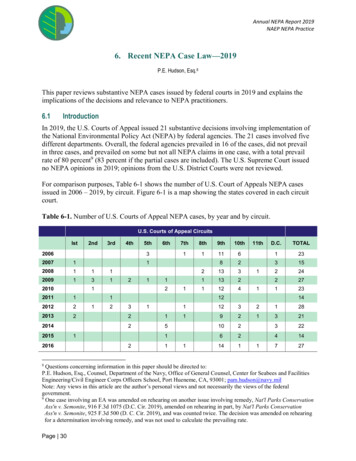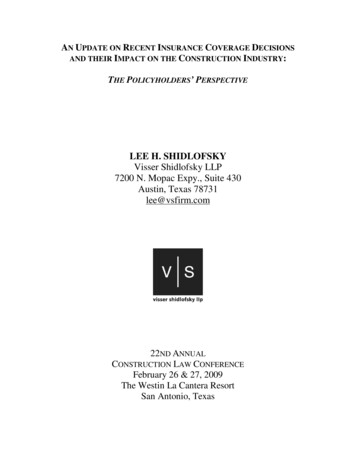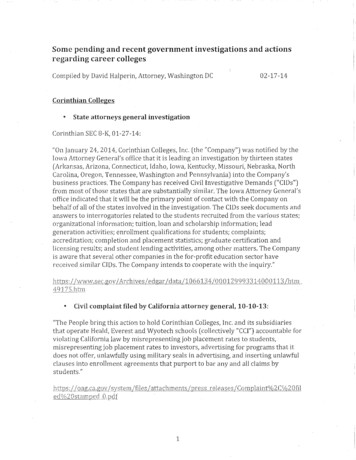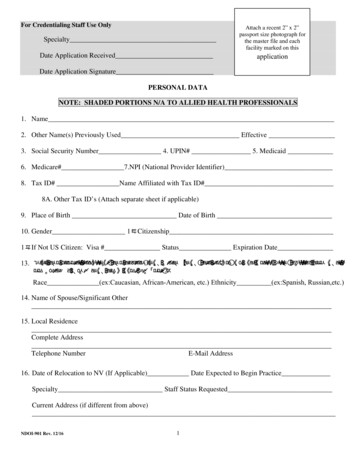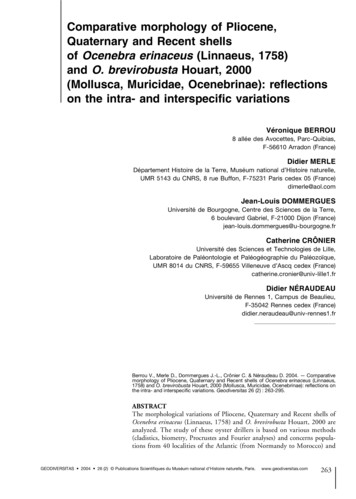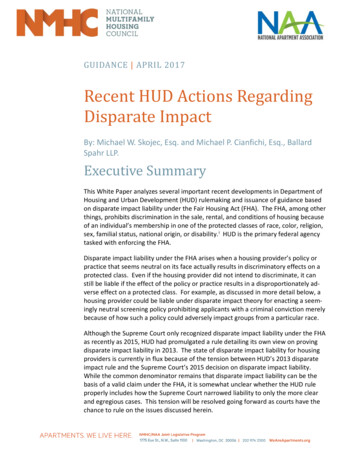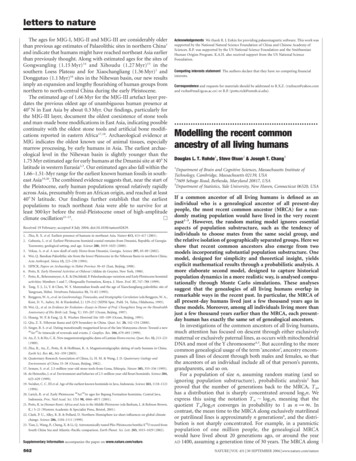
Transcription
letters to natureThe ages for MJG-I, MJG-II and MJG-III are considerably olderthan previous age estimates of Palaeolithic sites in northern China1and indicate that humans might have reached northeast Asia earlierthan previously thought. Along with estimated ages for the sites ofGongwangling (1.15 Myr)14 and Xihoudu (1.27 Myr)15 in thesouthern Loess Plateau and for Xiaochangliang (1.36 Myr)1 andDonggutuo (1.1 Myr)16 sites in the Nihewan basin, our new resultsimply an expansion and lengthy flourishing of human groups fromnorthern to north-central China during the early Pleistocene.The estimated age of 1.66 Myr for the MJG-III artefact layer predates the previous oldest age of unambiguous human presence at408 N in East Asia by about 0.3 Myr. Our findings, particularly forthe MJG-III layer, document the oldest coexistence of stone toolsand man-made bone modifications in East Asia, indicating possiblecontinuity with the oldest stone tools and artificial bone modifications reported in eastern Africa17,18. Archaeological evidence atMJG indicates the oldest known use of animal tissues, especiallymarrow processing, by early humans in Asia. The earliest archaeological level in the Nihewan basin is slightly younger than the1.75 Myr estimated age for early humans at the Dmanisi site at 408 Nlatitude in western Eurasia2,3. Our estimated ages also fall within the1.66–1.51-Myr range for the earliest known human fossils in southeast Asia19,20. The combined evidence suggests that, near the start ofthe Pleistocene, early human populations spread relatively rapidlyacross Asia, presumably from an African origin, and reached at least408 N latitude. Our findings further establish that the earliestpopulations to reach northeast Asia were able to survive for atleast 500 kyr before the mid-Pleistocene onset of high-amplitudeclimate oscillation21–23.AReceived 19 February; accepted 8 July 2004; doi:10.1038/nature02829.1. Zhu, R. X. et al. Earliest presence of humans in northeast Asia. Nature 413, 413–417 (2001).2. Gabunia, L. et al. Earliest Pleistocene hominid cranial remains from Dmanisi, Republic of Georgia:Taxonomy, geological setting, and age. Science 288, 1019–1025 (2000).3. Vekua, A. et al. A new skull of early Homo from Dmanisi, Georgia. Science 297, 85–89 (2002).4. Wei, Q. Banshan Paleolithic site from the lower Pleistocene in the Nihewan Basin in northern China.Acta Anthropol. Sinica 13, 223–238 (1994).5. HPICR, Papers on Archaeology in Hebei Province 30–45 (East, Beijing, 1998).6. Potts, R. Early Hominid Activities at Olduvai (Aldine de Gruyter, New York, 1988).7. Potts, R., Behrensmeyer, A. K. & Ditchfield, P. Paleolandscape variation and Early Pleistocene hominidactivities: Members 1 and 7, Olorgesailie Formation, Kenya. J. Hum. Evol. 37, 747–788 (1999).8. Tang, Y. J., Li, Y. & Chen, W. Y. Mammalian fossils and the age of Xiaochangliang paleolithic site ofYangyuan, Hebei. Vertebrata Palasiatica 33, 74–83 (1995).9. Berggren, W. A., et al. in Geochronology, Timescales, and Stratigraphic Correlation (eds Berggren, W. A.,Kent, D. V., Aubry, M. & Hardenbol, J.) 129–212 (SEPM Spec. Publ. 54, Tulsa, Oklahoma, 1995).10. Wei, Q., et al. in Evidence for Evolution—Essays in Honor of Prof. Chungchien Yong on the HundredthAnniversary of His Birth (ed. Tong, Y.) 193–207 (Ocean, Beijing, 1997).11. Huang, W. P. & Fang, Q. R. Wushan Hominid Site 105–109 (Ocean, Beijing, 1991).12. Qiu, Z. X. Nihewan fauna and Q/N boundary in China. Quat. Sci. 20, 142–154 (2000).13. Singer, B. S. et al. Dating transitionally magnetized lavas of the late Matuyama chron: Toward a new40Ar/39Ar timescale of reversals and events. J. Geophys. Res. 104, 679–693 (1999).14. An, Z. S. & Ho, C. K. New magnetostratigraphic dates of Lantian Homo erectus. Quat. Res. 32, 213–221(1989).15. Zhu, R., An, Z., Potts, R. & Hoffman, K. A. Magnetostratigraphic dating of early humans in China.Earth Sci. Rev. 61, 341–359 (2003).16. Quaternary Research Association of China, Li, H. M. & Wang, J. D. Quaternary Geology andEnvironment of China 33–38 (Ocean, Beijing, 1982).17. Semaw, S. et al. 2.5-million-year-old stone tools from Gona, Ethiopia. Nature 385, 333–336 (1995).18. de Heinzelin, J. et al. Environment and behavior of 2.5-million-year-old Bouri hominids. Science 284,625–629 (1999).19. Swisher, C. C. III et al. Age of the earliest known hominids in Java, Indonesia. Science 263, 1118–1121(1994).20. Larick, R. et al. Early Pleistocene 40Ar/39Ar ages for Bapang Formation hominins, Central Java,Indonesia. Proc. Natl Acad. Sci. USA 98, 4866–4871 (2001).21. Potts, R. in Human Roots: Africa and Asia in the Middle Pleistocene (eds Barham, L. & Robson-Brown,K.) 5–21 (Western Academic & Specialist Press, Bristol, 2001).22. Clark, P. U., Alley, R. B. & Pollard, D. Northern Hemisphere ice-sheet influences on global climatechange. Science 286, 1104–1111 (1999).23. Tian, J., Wang, P., Cheng, X. & Li, Q. Astronomically tuned Plio-Pleistocene benthic d18O record fromSouth China Sea and Atlantic–Pacific comparison. Earth Planet. Sci. Lett. 203, 1015–1029 (2002).Supplementary Information accompanies the paper on www.nature.com/nature.562Acknowledgements We thank R. J. Enkin for providing palaeomagnetic software. This work wassupported by the National Natural Science Foundation of China and Chinese Academy ofSciences. R.P. was supported by the US National Science Foundation and the SmithsonianHuman Origins Program. K.A.H. also received support from the US National ScienceFoundation.Competing interests statement The authors declare that they have no competing financialinterests.Correspondence and requests for materials should be addressed to R.X.Z. (rxzhucn@yahoo.comand rxzhu@mail.igcas.ac.cn) or R.P. (potts.rick@nmnh.si.edu).Modelling the recent commonancestry of all living humansDouglas L. T. Rohde1, Steve Olson2 & Joseph T. Chang31Department of Brain and Cognitive Sciences, Massachusetts Institute ofTechnology, Cambridge, Massachusetts 02139, USA27609 Sebago Road, Bethesda, Maryland 20817, USA3Department of Statistics, Yale University, New Haven, Connecticut 06520, USA.If a common ancestor of all living humans is defined as anindividual who is a genealogical ancestor of all present-daypeople, the most recent common ancestor (MRCA) for a randomly mating population would have lived in the very recentpast1–3. However, the random mating model ignores essentialaspects of population substructure, such as the tendency ofindividuals to choose mates from the same social group, andthe relative isolation of geographically separated groups. Here weshow that recent common ancestors also emerge from twomodels incorporating substantial population substructure. Onemodel, designed for simplicity and theoretical insight, yieldsexplicit mathematical results through a probabilistic analysis. Amore elaborate second model, designed to capture historicalpopulation dynamics in a more realistic way, is analysed computationally through Monte Carlo simulations. These analysessuggest that the genealogies of all living humans overlap inremarkable ways in the recent past. In particular, the MRCA ofall present-day humans lived just a few thousand years ago inthese models. Moreover, among all individuals living more thanjust a few thousand years earlier than the MRCA, each presentday human has exactly the same set of genealogical ancestors.In investigations of the common ancestors of all living humans,much attention has focused on descent through either exclusivelymaternal or exclusively paternal lines, as occurs with mitochondrialDNA and most of the Y chromosome4,5. But according to the morecommon genealogical usage of the term ‘ancestor’, ancestry encompasses all lines of descent through both males and females, so thatthe ancestors of an individual include all of that person’s parents,grandparents, and so on.For a population of size n, assuming random mating (and soignoring population substructure), probabilistic analysis2 hasproved that the number of generations back to the MRCA, T n,has a distribution that is sharply concentrated around log2n. Weexpress this using the notation T n , log2n, meaning that thequotient T n/log2n converges in probability to 1 as n ! 1. Incontrast, the mean time to the MRCA along exclusively matrilinealor patrilineal lines is approximately n generations6, and the distribution is not sharply concentrated. For example, in a panmicticpopulation of one million people, the genealogical MRCAwould have lived about 20 generations ago, or around the yearAD 1400, assuming a generation time of 30 years. The MRCA alongNATURE VOL 431 30 SEPTEMBER 2004 www.nature.com/nature
letters to natureBox 1Graph-theoretical definitionsThe length of a path in a graph, G, is the number of edges in the path.For each pair of nodes i and j in G, the distance d(i, j) is defined to bethe length of a shortest path joining i and j. The radius of G isR ¼ min{max dði; kÞ}i[Gk[Gand a node i is called a centre of G if maxk[G d(i, k) ¼ R. AssumeR 1; the case R ¼ 0 (G has one node) was treated previously2. Foreach centre node i, let S i be a set of minimal size that consists ofneighbours of node i and satisfies min {d( j, k): j [ {i} Si } # R 2 1 forall k [ G. H i is defined as the number of nodes in S i, H is the minimumof H i over all centres i, and D ¼ 1 2 H1 : The diameter of G isD ¼ maxi,k[G d(i, k).exclusively maternal lines would have lived something like 50,000times earlier—in the order of one million generations ago.As genealogical ancestry is traced back beyond the MRCA, agrowing percentage of people in earlier generations are revealed tobe common ancestors of the present-day population. Tracingfurther back in time, there was a threshold, let us say U n generationsago, before which ancestry of the present-day population was an allor nothing affair. That is, each individual living at least U ngenerations ago was either a common ancestor of all of today’shumans or an ancestor of no human alive today. Thus, among allindividuals living at least U n generations ago, each present-dayhuman has exactly the same set of ancestors. We refer to this point intime as the identical ancestors (IA) point. As with the MRCA point,the IA point is also quite recent in a randomly mating population:U n , 1.77 log2n generations ago2.The major problem in applying these results to human populations is that mating is not random in the real world. Matingpatterns are structured by geography, proximity, culture, languageand social class. Nevertheless, even in populations with considerableinternal structure, the time to the MRCA can be remarkably brief.To demonstrate this in a tractable mathematical model, consider apopulation of size n divided into randomly mating subpopulationsthat are linked by occasional migrants. The population is represented by a graph, G, with a node for each subpopulation.Edges indicate pairs of nodes that exchange a small number (forexample, one pair) of migrants per generation. Let R denotethe radius of G, and let D be a quantity ranging between 0 and 1that depends on the structure of G (see Box 1). A probabilisticanalysis (see Supplementary Information) shows that as n ! 1,T n , ðR þ DÞ log2 n: Furthermore, if we let D denote the diameter ofthe graph, then the number of generations, U n, since the IA pointsatisfies U n , ðD þ 1:77Þ log2 n:Computer simulations accord with these theoretical predictions.Tables 1 and 2 give distributions of T n and U n for small populationsof varying sizes in graphs with one node, three connected nodes, fivefully connected nodes and for a ten-node graph loosely based onworld geography as shown in Fig. 1. In these simulations, neighbouring subpopulations exchange one pair of migrants per generation. Each mean is calculated from 100 model runs. Althoughguaranteed to be accurate only for sufficiently large n, the theoretical predictions describe the simulations quite well even for modelswith just a few thousand individuals. Whenever n is doubled, T n isexpected to increase by R þ D, and U n is expected to increase byD þ 1.77. These predicted increases, which are listed in the lastcolumns of Tables 1 and 2, agree closely with the simulation results.To hazard a rough first guess about human recent commonancestors, we could extrapolate the results for the graph of Fig. 1 to agrowing population with a final size of 250 million. When applyingthis model to a growing population, the fixed population size thatprovides the best approximation is the size at the time that theMRCA lived. We take this effective population size to be 250 million,which is approximately the global population in the year AD 1.Starting from n ¼ 16,000, a population of 250 million is reachedby doubling 14 times. Approximating the increases in T n and U nbeyond the values seen in Tables 1 and 2 by their theoreticalpredictions for each doubling of n, we arrive at T n 34 þ 14 3 ¼76 generations (about 2,300 years) and U n 74 þ 14 6:77 ¼ 169generations (about 5,000 years). These estimates would suggest,with the exchange of just one pair of migrants per generationbetween large panmictic populations of realistic size, that theMRCA appears in about the year 300 BC , and all modern individualshave identical ancestors by about 3,000 BC . Such estimates areextremely tentative, and the model contains several obvious sourcesof error, as it was motivated more by considerations of theoreticalinsight and tractability than by realism. Its main message is thatsubstantial forms of population subdivision can still be compatiblewith very recent common ancestors.The dynamics of human subpopulations are much more complexthan those in the simple graph model discussed above. Althoughthese complexities make theoretical analysis difficult, a computermodel incorporating more complicated forms of population substructure and migration allows the demographic history of humanpopulations to be simulated. The Supplementary Informationcontains more details on the model and computations; here webriefly outline some of the main points.This model is based on a simplified projection of the world’sTable 1 Simulations of T nGraphn ¼ 1,000n ¼ 2,000n ¼ 4,000n ¼ 8,000n ¼ 16,000RþD.One nodeThree fully connected nodesFive fully connected nodesTen-node graph shown in Fig. 110.8 (0.4)14.0 (0.7)14.0 (0.5)21.1 (1.3)11.8 (0.4)15.6 (0.7)15.8 (0.5)24.3 (1.5)n ¼ 1,000n ¼ 2,00012.8 (0.4)17.1 (0.9)17.8 (0.5)27.6 (1.5)13.9 (0.3)18.9 (0.8)19.6 (0.5)30.5 (1.5)14.8 (0.4)20.3 (1.0)21.5 (0.6)33.8 (1.7)1.001.501.753.00.Means (standard deviations in parentheses) of T n (the number of generations back to the MRCA) for graph-structured populations exchanging a single pair of migrants per edge per generation. Thelast column shows R þ D, the expected asymptotic increase in T n per doubling of n.Table 2 Simulations of U nGraphn ¼ 4,000n ¼ 8,000n ¼ 16,000D þ 1.77.One nodeThree fully connected nodesFive fully connected nodesTen-node graph shown in Fig. 120.8 (1.6)27.4 (1.5)25.9 (1.3)46.3 (2.7)22.6 (1.5)30.3 (1.4)28.9 (1.4)53.0 (2.7)24.6 (1.5)33.4 (1.5)32.1 (1.7)59.8 (2.7)26.5 (1.6)36.2 (1.7)35.3 (1.5)66.8 (2.9)28.3 (1.4)38.9 (1.5)37.9 (1.4)73.6 (2.7)1.772.772.776.77.Means (standard deviations in parentheses) of U n (the number of generations back to the IA point) for graph-structured populations exchanging a single pair of migrants per edge per generation. Thelast column shows D þ 1.77, the expected asymptotic increase in U n per doubling of n.NATURE VOL 431 30 SEPTEMBER 2004 www.nature.com/nature563
letters to natureFigure 1 World map viewed as a ten-node graph. This graph has radius 3 and diameter 5.actual inhabited land masses and has three levels of substructure:continents, ‘countries’ and ‘towns.’ Figure 2 depicts the model’sgeography and migration routes used before AD 1500, with thecountries shown as squares and the number of towns per countrydiffering from continent to continent. Towns and countries represent both the local geographical areas and the relevant social andethnic groups from which most people find mates.The model uses a simplified migration system in which eachperson has a single opportunity to migrate from his or her town ofbirth. The probabilities of leaving a town or a country are set atvarious levels to reflect different migration patterns. Migrants whomove between towns can travel to any other town within thecountry. A migrant who leaves a country for another country withinthe same continent chooses the destination with a probability thatdiminishes as the inverse square of the geographical distance.Each continent has a number of port countries from whichmigrants can travel to another continent. A fixed, large percentage(for example, 95% in some simulations) of the migrants through aport come from the country in which the port is located, with theremainder drawn from other countries in the continent in proportion to their inverse squared distance. The value next to a port inFig. 2 is its migration rate, in people per generation, and the date inparentheses indicates when the port opens, if it is more recent thanthe start of the simulation in 20,000 BC . When a port opens, there isusually a single generation of migration at a higher rate than thesteady-state rate shown in the figure. After the year AD 1500,additional large ports, which are not shown, begin to open tosimulate colonization of the Americas, Australia and elsewhere.Immediately before this, the native population of the Americas ismarkedly reduced to simulate the effects of European-introduceddiseases7.Generations overlap in this model and we explicitly simulated thelifespan and the times at which mating and reproduction eventsoccur for each individual8,9, as described in more detail in Supplementary Information. The birth rate of each continent or islandwas individually adjusted so that the populations match historicalFigure 2 Geography and migration routes of the simulated model. Arrows denote portsand the adjacent numbers are their steady migration rates, in individuals per generation. Ifgiven, the date in parentheses indicates when the port opens. Upon opening, there isusually a first-wave migration burst at a higher rate, lasting one generation.564NATURE VOL 431 30 SEPTEMBER 2004 www.nature.com/nature
letters to natureestimates, and growth rates were higher in under-populated areas.Full-sized populations were used until the world populationreached 50 million in 1,000 BC . Subsequently, birth rates werereduced to achieve a worldwide level of 55 million, carried out insuch a way that sparsely populated areas were less affected. Thislimit was a computational necessity, but simulations show thatpopulation growth has little effect, especially if it occurs after theMRCA has died.With 5% of individuals migrating out of their home town, 0.05%migrating out of their home country, and 95% of port users born inthe country from which the port emanates, the simulations producea mean MRCA date of 1,415 BC and a mean IA date of 5,353 BC .Interestingly, the MRCAs are nearly always found in eastern Asia.This is due to the proximity of this region to both Eurasia and eitherthe remote Pacific islands or the Americas, allowing the MRCA’sdescendants to reach a few major world regions in a relatively shorttime.Arguably, this simulation is far too conservative, especially givenits prediction that, even in densely populated Eurasia, only 55.3people will leave each country per generation in AD 1500. If themigration rate among towns is increased to 20%, the local port usersare reduced to 80%, and the migration rates between countries andcontinents are scaled up by factors of 5 and 10, respectively, themean MRCA date is as recent as AD 55 and the mean IA date is 2,158BC . The predictions of the simple ten-node graph model sketchedearlier fall somewhere between these dates and those of the moreconservative computational model.The model also can be used to calculate the percentage of ancestrythat current individuals receive from different parts of the world. Ingenerations sufficiently far removed from the present, some ancestors appear much more often than do others on any currentindividual’s family tree, and can therefore be expected to contributeproportionately more to his or her genetic inheritance1,10,11. Forexample, a present-day Norwegian generally owes the majority ofhis or her ancestry to people living in northern Europe at the IApoint, and a very small portion to people living throughout the restof the world. Furthermore, because DNA is inherited in relativelylarge segments from ancestors, an individual will receive little or noactual genetic inheritance from the vast majority of the ancestorsliving at the IA point12.Several factors could cause the time to the true MRCA or IA pointto depart from the predictions of our model. If a group of humanswere completely isolated, then no mixing could occur between thatgroup and others, and the MRCA would have to have lived beforethe start of the isolation. A more recent MRCA would not arise untilthe groups were once again well integrated. In the case of Tasmania,which may have been completely isolated from mainland Australiabetween the flooding of the Bass Strait, 9,000–12,000 years ago, andthe European colonization of the island, starting in 1803 (ref. 13),the IA date for all living humans must fall before the start ofisolation. However, the MRCA date would be unaffected, becausetoday there are no remaining native Tasmanians without someEuropean or mainland Australian ancestry.No large group is known to have maintained complete reproductive isolation for extended periods. The populations on eitherside of the Bering Strait appear to have exchanged mates throughoutthe period documented in the archaeological record14. Religiousisolates such as the Samaritans occasionally have absorbed migrantsfrom outside the group15. Even populations on isolated Pacificislands have experienced occasional infusions of newcomers16.Even if rates of migration between some adjoining populationsare very low, the time to the MRCA tends not to change substantially. For example, with a migration rate across the Bering Strait ofjust one person in each direction every ten generations, rather thanthe ten per generation in the more conservative simulationdescribed earlier, T n only increases from 3,415 years to 3,668 years.Conversely, other factors could reduce the time to the MRCANATURE VOL 431 30 SEPTEMBER 2004 www.nature.com/naturefrom that predicted by the model. Examples of such factors includethe existence of more diverse intercontinental migration routes, thelarge-scale movement and mixing of populations documented inthe historical record17, marked individual differences in fertility18,and the population increase of the past two millennia, which wouldresult in more migrants.Actual migration rates among populations are very poorly knownand undoubtedly have varied considerably in different times andplaces. Studies of hunter-gatherer groups and subsistence agricultural communities have found that anywhere from 1% (ref. 19) to asmuch as 30% (ref. 20) of mates are from outside the group. Thetendency of most human groups to marry out with surroundinggroups, at least to a limited extent, links networks of ancestry withinspecific regions (see Famous.descents.html).Given the remaining uncertainties about migration rates andreal-world mating patterns, the date of the MRCA for everyoneliving today cannot be identified with great precision. Nevertheless,our results suggest that the most recent common ancestor for theworld’s current population lived in the relatively recent past—perhaps within the last few thousand years. And a few thousandyears before that, although we have received genetic material inmarkedly different proportions from the people alive at the time,the ancestors of everyone on the Earth today were exactly the same.Further work is needed to determine the effect of this commonancestry on patterns of genetic variation in structured populations21–24. But to the extent that ancestry is considered in genealogical rather than genetic terms, our findings suggest a remarkableproposition: no matter the languages we speak or the colour of ourskin, we share ancestors who planted rice on the banks of theYangtze, who first domesticated horses on the steppes of theUkraine, who hunted giant sloths in the forests of North andSouth America, and who laboured to build the Great Pyramid ofKhufu.AReceived 30 December 2003; accepted 14 July 2004; doi:10.1038/nature02842.1. Wachter, K. W. in Genealogical Demography (eds Dyke, B. & Morrill, W. T.) 85–93 (Academic, NewYork, 1980).2. Chang, J. T. Recent common ancestors of all present-day individuals. Adv. Appl. Probab. 31,1002–1026, 1027–1038 (1999).3. Derrida, B., Manrubia, S. C. & Zanette, D. H. On the genealogy of a population of biparentalindividuals. J. Theor. Biol. 203, 303–315 (2000).4. Ingman, M., Kaessmann, H., Pääbo, S. & Gyllensten, U. Mitochondrial genome variation and theorigin of modern humans. Nature 408, 708–713 (2000).5. Thomson, R., Pritchard, J. K., Shen, P., Oefner, P. J. & Feldman, M. W. Recent common ancestry ofhuman Y chromosomes: Evidence from DNA sequence data. Proc. Natl Acad. Sci. USA 97, 7360–7365(2000).6. Hudson, R. R. in Oxford Surveys of Evolutionary Biology (eds Harvey, P. H. & Partridge, L.) 1–44(Oxford Univ. Press, New York, 1990).7. Stannard, D. E. American Holocaust: Columbus and the Conquest of the New World (Oxford Univ. Press,New York, 1992).8. US National Office of Vital Statistics, Death Rates by Age, Race, and Sex, United States, 1900–1953,Vital Statistics—Special Reports Vol. 43 (US Government Printing Office, Washington DC, 1956).9. Pletcher, S. D. Model fitting and hypothesis testing for age-specific mortality data. J. Evol. Biol. 12,430–439 (1999).10. Ohno, S. The Malthusian parameter of ascents: What prevents the exponential increase of one’sancestors? Proc. Natl Acad. Sci. USA 93, 15276–15278 (1996).11. Derrida, B., Manrubia, S. C. & Zanette, D. H. Distribution of repetitions of ancestors in genealogicaltrees. Physica A 281, 1–16 (2000).12. Wiuf, C. & Hein, J. On the number of ancestors to a DNA sequence. Genetics 147, 1459–1468 (1997).13. Jones, R. Tasmanian archaeology: Establishing the sequences. Ann. Rev. Anthropol. 24, 423–446 (1995).14. Fitzhugh, W. W. & Chausonnet, V. (eds) Crossroads of Continents: Cultures of Siberia and Alaska(Smithsonian Institution Press, Washington DC, 1988).15. Bonné-Tamir, B. et al. Maternal and paternal lineages of the Samaritan isolate: Mutation rates andtime to most recent common male ancestor. Ann. Hum. Genet. 67, 153–164 (2003).16. Morton, N. E., Harris, D. E., Yee, S. & Lew, R. Pingelap and Mokil atolls: Migration. Am. J. Hum. Genet.23, 339–349 (1971).17. Hoerder, D. Cultures in Contact: World Migrations in the Second Millennium (Duke Univ. Press,Durham, North Carolina, 2002).18. Zerjal, T. et al. The genetic legacy of the Mongols. Am. J. Hum. Genet. 72, 717–721 (2003).19. Weiss, K. M. & Maruyama, T. Archeology, population genetics and studies of human racial ancestry.Am. J. Phys. Anthropol. 44, 31–50 (1976).20. Ward, R. H. & Neel, J. V. Gene frequencies and microdifferentiation among the Makiritare indians. IV.A comparison of a genetic network with ethnohistory and migration matrices; a new index of geneticisolation. Am. J. Hum. Genet. 22, 538–561 (1970).565
letters to nature21. Jorde, L. B. in Current Developments in Anthropological Genetics (eds Mielke, J. H. & Crawford, M. H.)135–208 (Plenum, New York, 1980).22. Notohara, M. The coalescent and the genealogical process in geographically structured populations.J. Math. Biol. 29, 59–75 (1990).23. Wilkinson-Herbots, H. M. Genealogy and subpopulation differentiation under various models ofpopulation structure. J. Math. Biol. 37, 535–585 (1998).24. Hey, J. & Machado, C. A. The study of structured populations—new hope for a difficult and dividedscience. Nature Rev. Genet. 4, 535–543 (2003).Supplementary Information accompanies the paper on www.nature.com/nature.Acknowledgements The research of D.L.T.R. was supported by the National Institutes of Health.Competing interests statement The authors declare that they have no competing financialinterest
all present-day humans lived just a few thousand years ago in these models. Moreover, among all individuals living more than just a few thousand years earlier than the MRCA, each present-day human has exactly the same set of genealogical ancestors. In investigations of th
